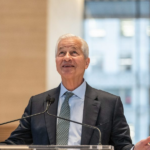The much-anticipated revival of the earnings season is off to a robust commencement, defying the prevailing uncertain macroeconomic landscape. Initial signs suggest that the forecasts predicting an end to the earnings recession are passing the litmus test.
With 32 S&P 500 companies having already reported their earnings, it’s evident that firms within this index are surpassing Wall Street’s projections by an impressive 9% on earnings per share, as confirmed by the Bank of America Research’s equity strategy team. Remarkably, after two consecutive quarters of decline, the earnings per share (EPS) for S&P 500 firms has managed to climb by 1% when compared to the same quarter of the previous year, signaling a potential end to the corporate earnings recession in the United States.
In a research note released on Monday, Lori Calvasina, the Head of US Equity Strategy at RBC Capital, described the onset of earnings season as “solid,” despite the looming “macro headwinds.”
Notably, despite challenges such as persistent inflationary pressures and the Federal Reserve’s commitment to a prolonged policy stance, RBC Capital has decided to raise its EPS forecast for the S&P 500. This decision is rooted in RBC’s updated analysis of recent macroeconomic shifts, resulting in an increase of S&P 500 earnings to $223 for 2023 (up from the previous $220) and $232 for 2024 (up from the earlier $229).

While this boost in Q3 earnings estimates may suggest a brighter outlook for the index, Lori Calvasina’s S&P 500 price target for 2023 remains unchanged at 4,250. The reason behind this is the realization that S&P 500 EPS is merely one of several factors influencing their predictions.
Stepping back and looking beyond earnings alone, Calvasina still sees a complex macroeconomic landscape. She stated, “Our analysis of S&P 500 earnings call transcripts since late September indicates that the macroeconomic environment is indeed taking its toll. Companies continue to emphasize the resilience of consumers, who have become more discerning in their spending habits. We also notice discussions about how macroeconomic uncertainties, including inflation and interest rate policies, are impacting demand and spending, particularly from the corporate perspective. The commentary on pricing trends remains mixed, with a notable focus on moderation.”
Interestingly, during the early stages of earnings season, it appears that the figures reported by companies are influencing stock performance more significantly than the headwinds they might mention.
A prime example of this phenomenon can be observed in JPMorgan’s recent earnings release. The Chairman and CEO of the leading American financial institution, Jamie Dimon, expressed a bleak outlook on the geopolitical tensions in the Middle East, stating, “This may be the most dangerous time the world has seen in decades.” However, investors seemed to be more fixated on the exceptional quarter of profits, as the stock surged more than 1.5% on the day of the release.
A similar trend is visible in the broader S&P 500 index, which has risen nearly 1% since the release of robust earnings results by Pepsi on October 10.









